The Lost Inventions of Buckminster Fuller (Part 2 of 3)
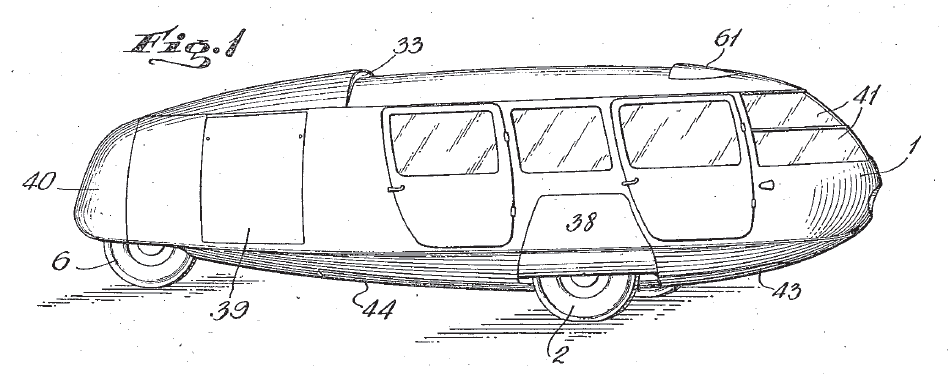
The Lost Inventions of R. Buckminster Fuller is a three-part investigation into the inventions of Buckminster Fuller. These essays can serve as companion essays for two previous books by and about Fuller: Inventions (Fuller, St. Martin’s Press 1983) and The Dymaxion World of Buckminster Fuller (Marks and Fuller, Doubleday 1973). Ownership of these two books is not necessary for reading these essays. Page numbers without citations are from Inventions Fuller made many claims about his inventions, claims which are confirmed or called into question by these essays. A new appreciation for Fuller’s innovations is the result.
Fuller claimed that his life goal was to provide humanity with the means to save itself from itself and from natural disasters. To that end Fuller could have given his inventions up to the public domain, making them more accessible to more people. But Fuller sought, obtained and defended patents for many of his inventions, for two reasons.
First, Fuller hoped that the long-term and public nature of the US Patent Office would serve as a long-term and public record of his work. Fuller wrote in Inventions: “The public record established by my patents […] can serve as a critical appraisal of the historical relevance, practicality, and relative effectiveness of my half-century’s experimental commitment to discover what, if anything, an individual human being eschewing politics and money-making can do effectively on behalf of all humanity.”
Second, Fuller hoped to prevent others from profiting from his inventions. Donald W. Robertson served as Fuller’s patent attorney and wrote about his experience in The Mind’s Eye of Buckminster Fuller (Robertson, St. Martins 1983). Robertson described why Fuller sought patents: “While Fuller did not wish to seek patent profits by selling efforts, he was adamant in seeking to forestall efforts of others to profit by making unauthorized use of his inventions.” Fuller defended his patent interests. Fuller’s archive includes legal disputes over royalties with North American Aviation between 1958 and 1961 and with Ernest Okress between 1978 and 1979. According to Siobhan Roberts’ book on mathematician Donald Coxeter, King of Infinite Space (Roberts, Walker & Co. 2006), Fuller’s patent on the Radome was defended in Canada by the United States Department of Defense. Fuller sought and sometimes obtained intellectual property rights in Argentina, Belgium, Bolivia, Brazil, Canada, Chile, Columbia, The Congo, Costa Rica, El Salvador, Finland, France, Greece, India, Iran, Iraq, Israel, Italy, Jamaica, Japan, Jordan, Kenya, Korea, Luxembourg, Mexico, New Zealand, Nicaragua, Norway, Pakistan, Panama, Paraguay, Poland, Portugal, South Africa, Spain, Switzerland, Turkey, the United State, the United Kingdom, Uruguay, Venezuela and West Germany.
All of Fuller’s inventions are lost in some way. All of Fuller’s U. S. patents are lost in that they have expired. Some of Fuller’s patents expired in his lifetime. This is due to his being unable to afford a renewal, or his deciding to let a patent expire, or perhaps neglect. Many of Fuller’s patents lost their references to earlier patents by other inventors. That is, what Fuller claimed he invented was in fact invented by someone else. Sometimes Fuller was ignorant of prior work, such as the octet-trus constructions of Alexander Graham Bell. Sometimes Fuller stole ideas whole-cloth, such Kenneth Snelson’s sculptures re-branded as Fuller’s tensegrity. Some of Fuller’s patents are lost because they have yet to go into production, existing only as scale models. Perhaps now that Fuller’s patents have expired some of them can be tested against Fuller’s claims. Perhaps the fog gun could be tested in arid environments, for instance. Many of Fuller’s patents are lost to the curious because they are not always filed under their popular name. The patent for the geodesic dome is to be found under the title ‘Building Construction,’ which has likely caused some researchers difficulty in finding it. Some of Fuller’s patents are lost because they are under-documented. Automobile restoration firm Crosthwaite and Gardiner had access to nearly all the information ever produced about the Dymaxion Car, but at times had to make their best guess in the creation of Dymaxion Car #4 because detailed schematics and photographs were not available. The credits to many of the illustrations in Inventions are lost. Illustrations appear in the book without further information. The photograph on the front cover is a 36-foot geodesic dome made by students at the University of Minnesota and assembled in Aspen, Colorado in 1952. Additional photographs of this dome can be found in Dymaxion World illustrations 334-339. The end papers show the paperboard dome of 1954. Page vi shows Fuller with a partially-assembled model of the 4D House in New York City in 1929. Page xi shows Fuller at Black Mountain College in 1948. Pages xvii and xviii appear to be Fuller at the Montreal World’s Fair dome. The photographs on pages xiv, xxvi-xxvii, xxxi and xxxii are of unknown origin.
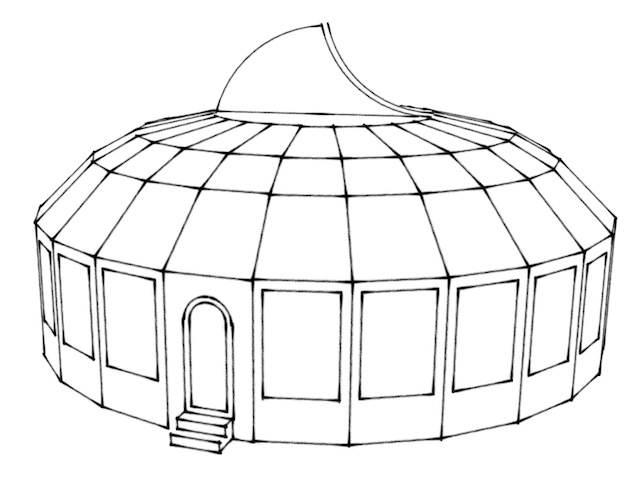
The Dymaxion House / Wichita House is a house suspended from a central mast. The Dymaxion House / Wichita House of 1946 has no patent. In Inventions Fuller directs the readers to Grunch of Giants as to why the Dymaxion House did not go into production. Grunch of Giants claims this was due to a lack of a distribution system, difficulties with building codes, resistance from electricians and plumbers unions and an unwillingness by banks to offer mortgages. But there is no published explanation why Fuller or someone else did not patent the Dymaxion House. Grunch claims the Dymaxion House was designed in 1927, modeled in 1928 and helicopter-delivered in 1954. The Wichita House appears in Dymaxion World illustrations 184-227. Much of Fuller Houses by Federico Neder concerns the Dymaxion House. The most important information on why the Dymaxion House never went into production can be found on pages 85-114 of Martin Pawley’s Buckminster Fuller. Namely, this was due to Fuller’s “fanatical determination to retain complete personal control of the project and refine the house still further before putting it into production.” Although there were estimates of 250,000 Dymaxion Houses to be produced each year and 37,000 unsolicited orders before production began, not one complete full scale Dymaxion House was ever made. When the Henry Ford Museum attempted to restore the full size Dymaxion House, they learned that what is seen in photographs are two incompatible models, an interior and exterior. Only miniature models exist in complete form.
The Dymaxion House was one of Fuller’s best opportunities for financial success. Funding was available, materials and equipment was at hand, trained labor stood ready, but Fuller scuttled the entire operation. The challenges Fuller described in Grunch of Giants may have existed, but these challenges exist for every manufacturer and architect and designer who, nonetheless, are able to produce their work. Fortune magazine described the Dymaxion House as the industry that industry missed.
How the Dymaxion House was scuttled is underdocumented. The documentary Thinking Out Loud claims that the manufacturer was ready to proceed but Fuller objected, claiming the need for more testing. In Buckminster Fuller: An Autobiographical Monologue / Scenario (edited by Robert Snyder) Fuller speaks of the Dymaxion House being ready for mass production but says nothing about why this did not happen. J. Baldwin writes: “To prevent the marketing of an unperfected product, he ‘hid’ the engineering drawings by stamping them ‘obsolete.'” How Fuller was able to walk away with a design he did not own the intellectual property to is unknown.
But it could be that the Dymaxion House was simply not a viable product. Architect Philip Johnson had much to say about Fuller and the Dymaxion House in Thinking Out Loud, only a small amount of which was used. From the unaired transcript:
[The] Dymaxion House was probably the worst planned dwelling in the world. A round, small round space. Unless you’re an igloo, unless you like igloos and live like Eskimos in one room. But he believed in privacy, so he carved it up and made rooms at the beds. If you look at the plans today it is to laugh. The bed never got into the pie shape, pie shape room. There’s no way architecturally to make it work. But he tried anyhow. And he put an arched door in this mechanical looking thing.
And then he held it up in the central mast. Well if there’s one way not to hold up a house, it’s from the center. Frank Lloyd Wright tried the same thing you know. I mean it was in the air. It was in the air. A lot later it went into art through Snelson but in engineering it lasted for a long time. You hold down a building on the outside and hold it up in the middle. Well isn’t it easier, any common person would say, to hold it up all over? Why do you hold it all up and then pull it down again? Never made any sense. But ideologically it made wonderful sense. We have this central mast - you could see the poetry that would fit around a circular building around a mast. Perfect. Had nothing at all to do with architecture and all to do with dreams and pseudo mechanics.
Fuller describes an overhead-trolleyed, tensionally supported telephone in Dymaxion World. This appears to be a candlestick telephone hanging from a track that could be slid between desks in an office. Fuller never sought a patent for this telephone trolley.
Fuller describes a criss-cross, tensionally supported table in Dymaxion World. This appears to be a table supported by wires. Fuller never sought a patent for this table. Furniture suspended from above is as old as the first porch swing or folding table on a ship, but this particular suspended table is somewhat novel. Fuller never sought a patent for this tensionally supported table.
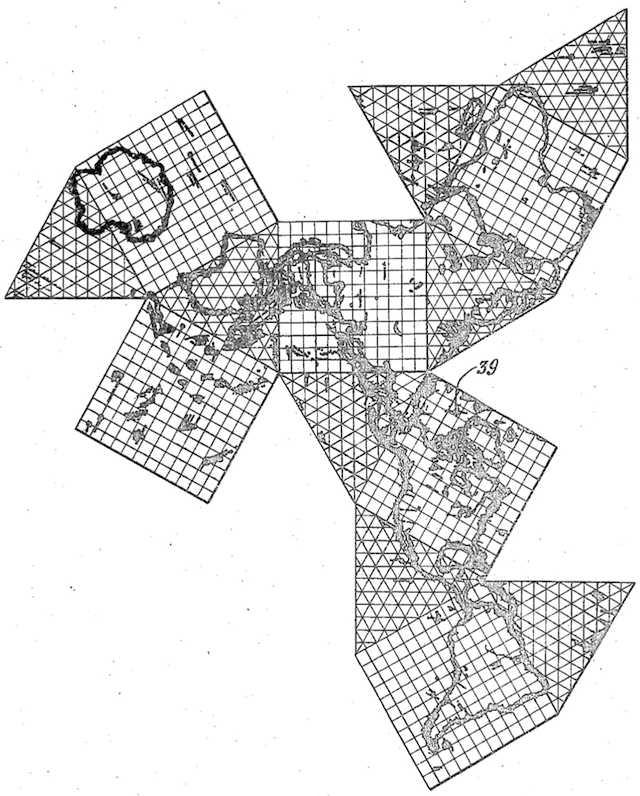
The Dymaxion Map is a map of the world. The Dymaxion Map is titled Cartography in patent 2,393,676 (29 January 1946). Grunch of Giants claims the Dymaxion Map was discovered in 1933 and published in 1943. Although Fuller wanted to employ an undistorted map in his efforts to coordinate people’s needs with existing resources, and although the Dymaxion Map is a worthy addition to the history of cartography, it is not a map free of distortion. All flat maps of curved surfaces are distorted. The Dymaxion Map distorts in a novel way, but it still distorts. Fuller claims that after the Dymaxion Map appeared in Life magazine it was described as “pure invention” by “several great experts.” This description was used by Fuller’s patent attorney to convince the Patent Office Fuller’s work deserved a patent. Fuller’s “pure invention” claim does not appear in Robertson’s The Mind’s Eye. Robertson quotes Fuller saying “The problem of the navigator is how to sail or fly the shortest course, which on a conventional chart will be a curved line. I simply design an unconventional chart which is so constructed that all future navigators can find their courses as straight lines. This means that I will need a new kind of map projection in which all great circles of a sphere will be seen as straight lines.” Fuller claimed that his 1947 world map patent was the first to be granted since 1900, when the U. S. Patent office ruled all possible methods had been considered. But Allan C. Clark had been granted patent 2,369,103 in February 1945 for “flat map sections which may be detachably assembled upon a support to form globe maps.” And on 12 December 1924 Samuel W. Balch had been grated patent 1,610,413 for a map with the following features:
For the purposes of navigation it is important to have maps or charts on flat or plane sheets which fulfill three mathematical conditions. First, the construction should be such that it will be convenient to draw on the map the course of the shortest sea-level line between any two points, and to ascertain the latitude and longitude at any intermediate point of the course. Such a line is commonly known as the arc of a great circle and would be if the earth were a true sphere but is in, fact a line to be otherwise defined since the earth approximates closely to a spheroid or ellipsoid of revolution, and will be termed a geodesic line. Second, it should be convenient to ascertain the angle at which any geodesic line crosses any intermediate meridian.
Gene Keyes has documented the work of B. J. S. Cahill and Cahill’s Butterfly World Map. The Butterfly World Map is a globe flattened into eight symmetrical rounded triangles in which the sinus lines do not cut through large land masses and distortion of land masses is kept at a minimum. These are claims make by Fuller for his Dymaxion Map, but the Butterfly World Map was introduced in 1909. Cahill spoke of his Butterfly World Map in 1912:
The ideal way to study the world is by use of a globe, and all geographers are agreed on this point, it follows that a map which is identical with the surface of a globe, laid out literally on a plane, must be the best as being nearest to an actual globe. […] I will go further and say that a map so made has advantages that a globe has not. One of them is that the map shows the entire world at one coup d’il, whereas on a large globe one can only see about a third of the earth’s surface at one time.
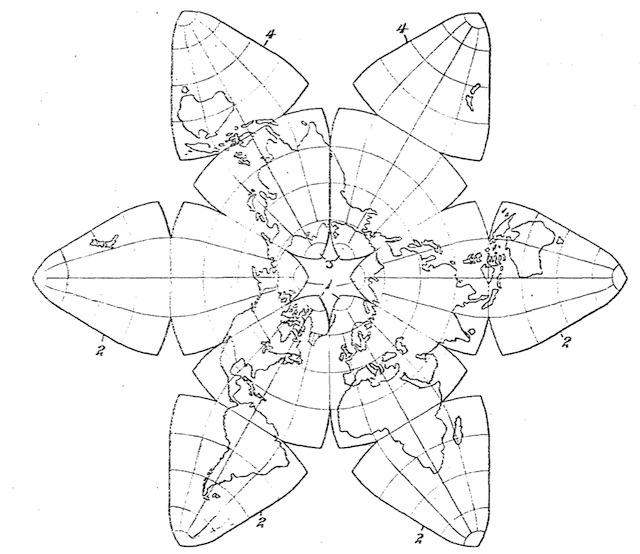
The patent specifies that the Dymaxion Map is “resolved into six equilateral square sections and eight equilateral triangular sections.” This does not describe the icosohedral Dymaxion Map (known as the Raleigh projection) that is often associated with patent 2,393,676. Inventions mentions the Dymaxion Map in Life magazine, but not one of the ways in which this “flat map shows [the] world in many perspectives.” This was the “Jap Empire.” “The ruthless logic of the Jap imperialism is exposed by this layout of the Dymaxion World map. The “Jap Empire” was not included in the reprint from Life found in Dymaxion World page 153.
The Dymaxion Map is preceded by similar inventions, although there is no indication that Fuller was aware of them.
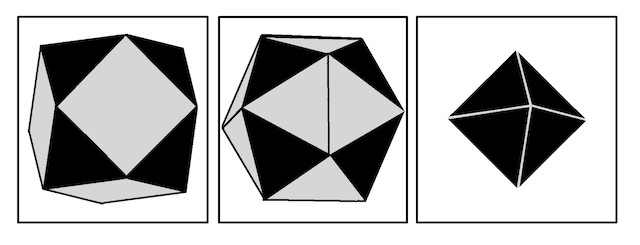
The Jitterbug Transformation appears in Fuller’s work starting in 1948, as part of his study of the closest packing of spheres.
What Fuller discovered was that a wire-frame cuboctahedron with flexible vertices has the property of flexing into other shapes. If the upper and lower triangular face are pushed toward each other, the cuboctahedron forms a shape similar to the icosahedron (although missing some edges). If the upper and lower triangles are pushed further toward each other, the cuboctahedron forms an octahedron. A flexible cuboctahedron can be manipulated further to form a tetrahedron and a triangle. These transformations were entirely the discovery of Buckminster Fuller.
The Autonomous Package is a collection all the furniture and utilities needed by a family of six packed into a single container. The Autonomous Package was developed by Fuller and students at the Dearborn Street Institute of Design in Chicago, Illinois in 1948. This project predicted the utility of intermodal containers, standardized containers that can be filled and delivered by air, sea and land without being repackaged. This project also predicted the popularity of stores like Ikea, which sells collections of furniture and utilities in ready-to-assemble form.
Fuller never attempted to patent the Autonomous Package. In Dymaxion World he write that the Autonomous Package was “not significant in its superficial results.” The Autonomous Package is a case of Fuller demonstrating the feasibility and cost-effectiveness of a technique then moving on, with the world adopting his discovery while not knowing its origin.
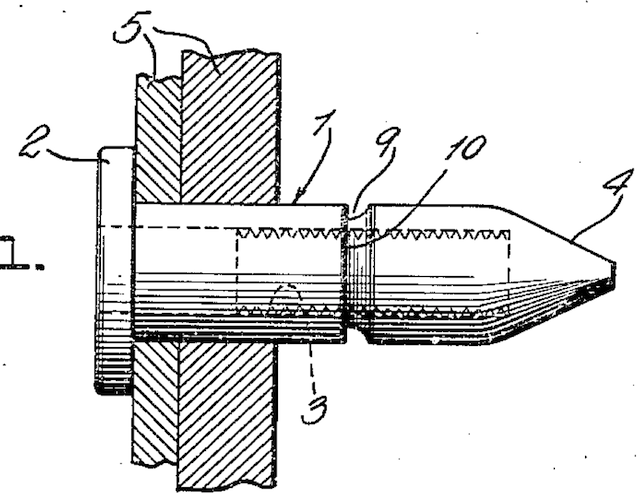
Dymaxion patent Fastening Means 2,466,013 (5 April 1949) is not mentioned in Inventions, Dymaxion World or in any other Fuller title. Fastening Means (2,466,013) was filed by Bill Dean Eaton. Fastening Means reads: “This invention particularly relates to fastenings of the blind rivet type comprising a malleable metal tubular stud having an outside flange at one end and with its inside provided with a screw thread with the thread starting at a position spaced from the flanged end and extending toward the opposite end of the stud this latter end being either open or closed.”
While not limited to use on a Dymaxion Dwelling Unit, this patent was assigned to the Dymaxion Company. In some cases Fuller was able to give partial credit to prior inventions, or to share the stage with other inventors. James Monroe Hewitt’s patent 1,633,702 for Building Structure (28 June 1927) appears in both the Chronofile and Inventions. Hewitt’s earlier patent 1,631,373 for Partition Walls (7 June 1927) appears in the Chronofile but not in Inventions. The Tensegrity Trus of Christopher J. Kitrick appears in Inventions. But the Dymaxion patent for Fastening Means is lost in the Fuller literature.
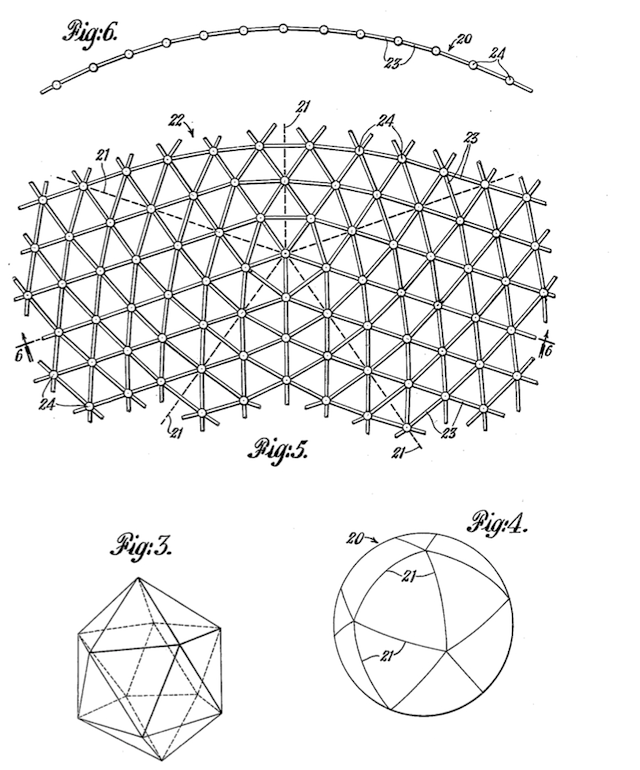
The Geodesic Dome is a shelter shaped like an inverted bowl. The Geodesic Dome is called Building Construction in patent 2,682,235 (29 June 1954). The photograph on page 128 was taken inside the Climatron in St. Louis, Missouri USA. The photograph on page 138-139 was taken outside the U. S. Pavilion at the Montreal World’s Fair. It is unknown where the photographs on pages 132, 1134-135 were taken. Fuller’s U. S. patent was granted on 29 June 1954, his Canadian patent in 1955, but this is not the first patent for a geodesic dome.
The first patent for a geodesic dome was awarded to Walter Bauersfeld (1879-1959) in 1925. Bauersfeld’s patent is Reichspatentamt Patentschrift Nr. 415395 Klasse 37a Gruppe 2. A U. S. patent preceding Fuller’s geodesic dome is Insulation for Spherical Tank Shells and Methods for Making the Same (2,470,986), granted to J. O. Jackson on 24 May 1947. Jackson’s patent describes the faces of an icosahedron divided into any number of triangles, the projection of the vertices of these triangles outward until they intersect with the surface of a sphere, then connecting the points of intersection with radial lines forming the chords of great circles. The resulting “dome-like” structure is described as “less troublesome, costly, and wasteful” as conventional structures. 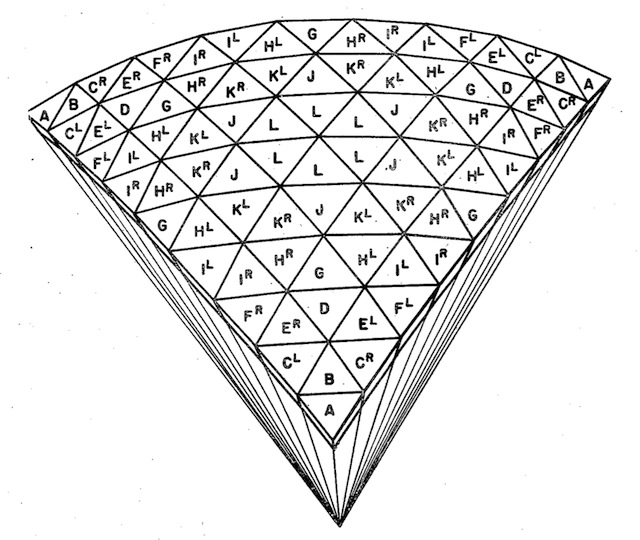 Jackson’s patent, in turn, makes reference to patent 2,424,601 - Icosahedral Map by J. E. Crouch, granted on 29 July 1947.
Jackson’s patent, in turn, makes reference to patent 2,424,601 - Icosahedral Map by J. E. Crouch, granted on 29 July 1947.
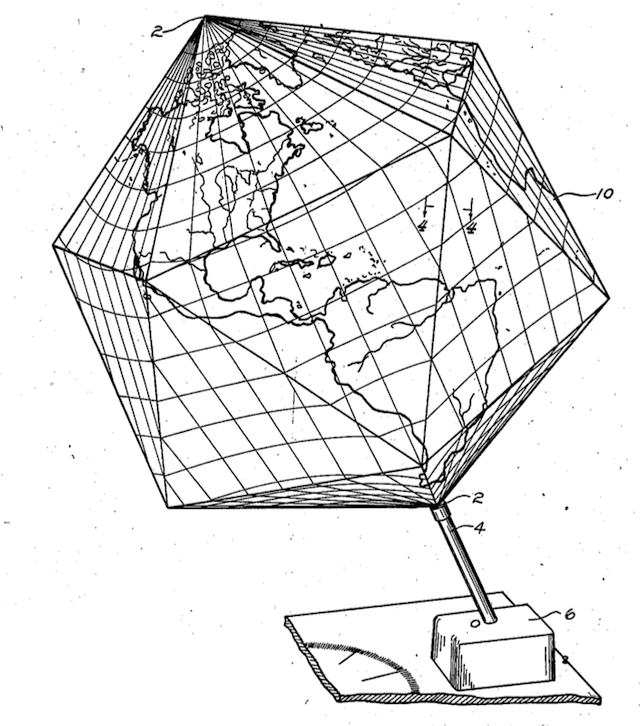
The Geodesic Dome is preceded by similar inventions, although there is no indication that Fuller was aware of them at the time of his patent.
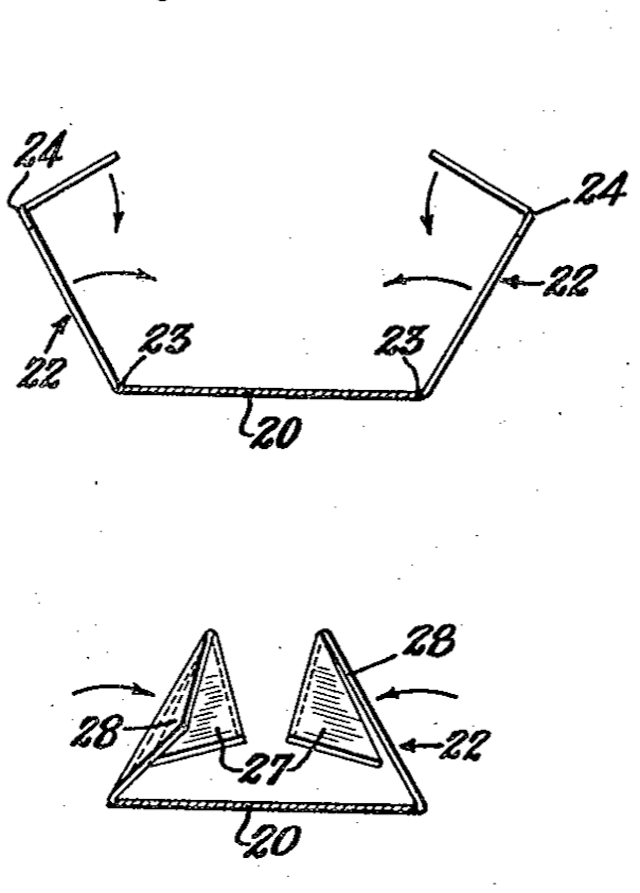
The Paperboard Dome is a kind of Geodesic Dome, made of folded cardboard tubes and panels. The Paperboard Dome is called Building Construction in patent 2,881,717 (14 April 1959). Canadian patents were awarded the same year. The photograph on page 146 features the 1954 Mark II dome, which can be seen in illustrations 426-433 of Dymaxion World (see also Military Domes). The twenty-foot paperboard dome and the Lower East Side gang that built it mentioned by Fuller is described at length in CHARAS by Syeus Mottel.
The Paperboard Dome, as a dome, is preceded by similar inventions. But the use of what is now known as cardboard in this folded form is unique to Fuller.
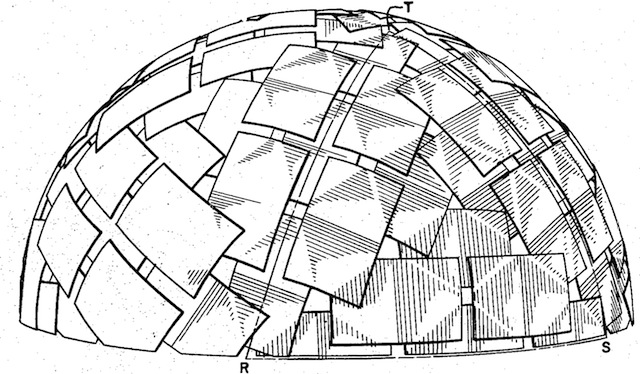
The Plydome is a kind of Geodesic Dome, made of overlapping sheets of plywood. The Plydome is called Self-Strutted Geodesic Plydome in patent 2,905,113 (22 September 1959). Dymaxion World illustrations 435-442 show other plydomes. The Geodesic Plydome chapel of Colombian Fathers in illustration 447 was built in 1957, the year Canadian patents for the Plydome were awarded to Fuller.
The PlyDome, as a dome, is preceded by similar inventions. But while shingling is an old architectural form, shingles-as-roof-and-walls is a form unique to Fuller.
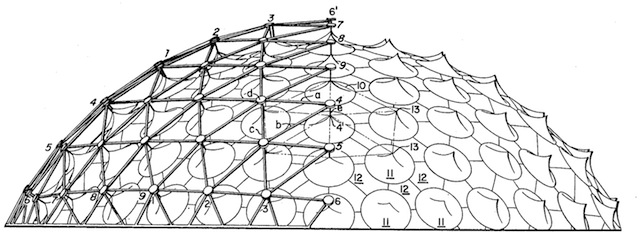
The Catenary (Geodesic Tent) is a kind of Geodesic Dome, made of a tent suspended from a metal geodesic frame at multiple points. The Catenary Dome is called called Geodesic Tent in patent 2,914,074 (24 November 1959). The Alaskan dome mentioned by Fuller was built by Synergetics Inc. of Raleigh NC USA in 1956. The 100-foot diameter dome was erected, disassembled, shipped and re-assembled in Afghanistan, Algeria, El Salvador (twice), France, Osaka (Japan), Peru, Syria, Thailand, Tokyo (Japan) and Uruguay before its use in the 1967 Alaskan Centennial. This was one of the most field-tested domes ever made and there is no record of it having given sub-standard performance. One wonders what the town of Fairbanks did with the dome after it was disassembled. The second Dymaxion Car vanished for decades. Perhaps the Alaska dome will likewise make a dramatic reappearance.
The Cantenary Geodesic Tent, as a dome, is preceded by similar inventions. But the application of circus-tent like structures to the dome’s facets is a form unique to Fuller. Millions of modern camping tents, with their dome shape supported by tension members, owe their existence to Fuller’s Cantenary Geodesic Tent.
- Trevor Blake
Trevor Blake is the author of the Buckminster Fuller Bibliography, available at synchronofile.com